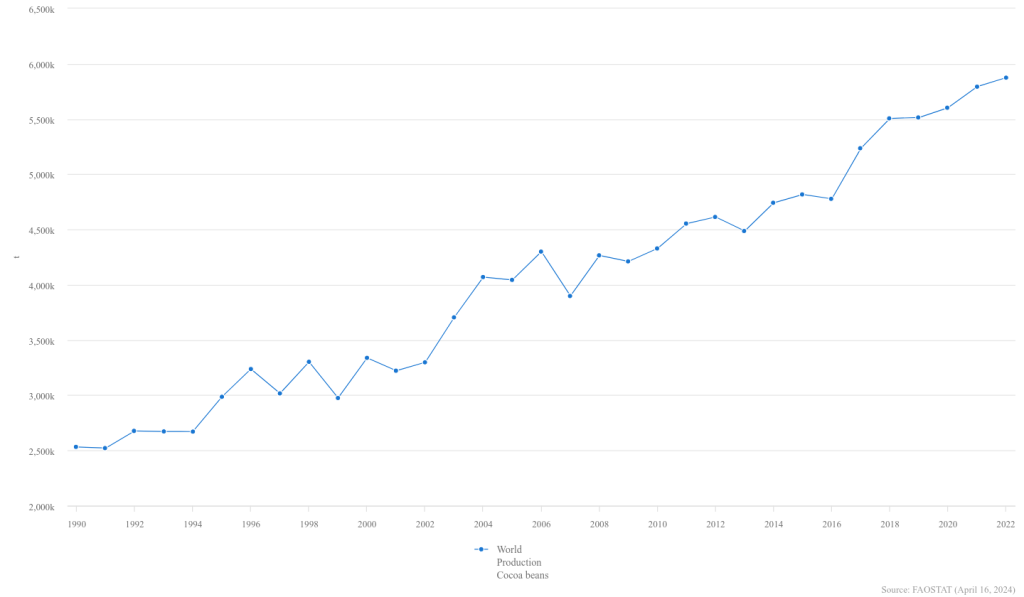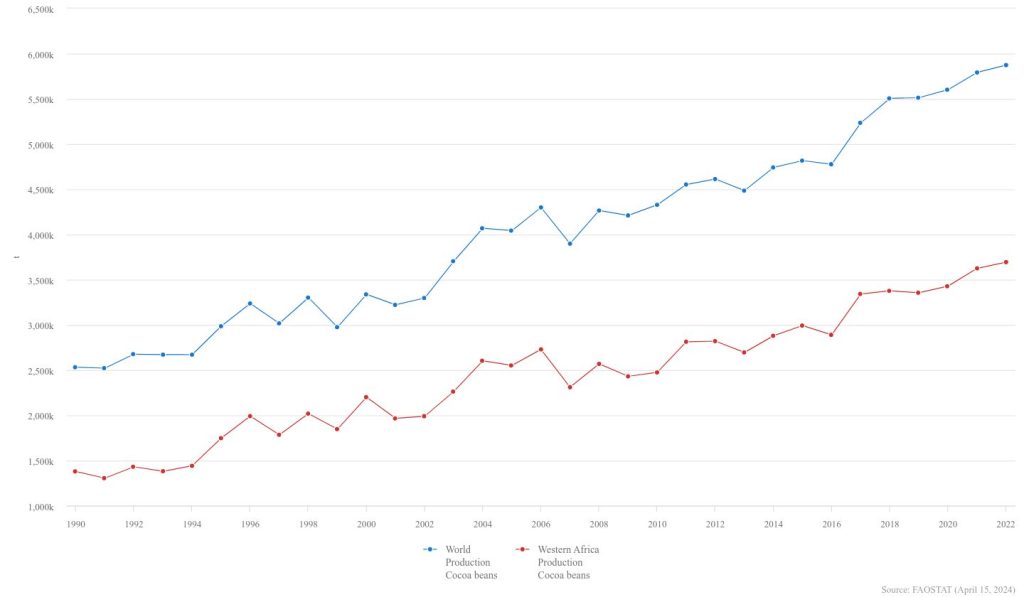An article from the Wall Street Journal, “Cocoa and Coffee Prices Have Surged. Climate Change Will Only Take Them Higher,” claims that climate change is driving recent spikes in the price of cocoa and coffee, and that things will likely get worse as warming continues. This is false. Cocoa and coffee have both set production records multiple times during the recent period of slight warming. A single bad season, or even a few bad seasons, for certain crops in certain regions of the world is not indicative of long-term change, significant shift, or trend.
The Wall Street Journal (WSJ) reports that prices for coffee and cocoa are “surging as severe weather events hamper production in key regions, raising questions from farm to table over the long-term damage climate change could have on soft commodities.”
The WSJ adds that “more frequent heat waves, heavy rainfalls and droughts are damaging harvests and crippling supplies amid ever growing demand from customers worldwide.”
As discussed in multiple Climate Realism posts, data refutes claims that heat waves, droughts, or heavy rainfall are becoming more severe or more frequent. Also both coffee and cocoa bean production has enjoyed a steady climb over the decades, even amid modest warming.
Heat waves, heavy rain, and drought are all weather events that certainly can, and often do, impact crop production for a wide range of produce, not just cocoa and coffee, but evidence that these events are becoming a bigger threat to production is lacking.
The WSJ themselves point to a natural cause of the most recent heat waves and rainfall in West Africa, home of 70% of cocoa production: “powerhouses Ivory Coast and Ghana are facing catastrophic harvests this season as El Niño—the pattern of above-average sea surface temperatures—led to unseasonal heavy rainfalls followed by strong heat waves.”
This year’s heat and rain in both Africa and other parts of the world have been driven largely by El Niño, as discussed by Climate Realism here, for example, but that phenomenon is temporary, natural, and likely has already ended.
If it were true that climate change was leading to an increase in these kinds of events, that trend should be reflected in production data of coffee and cocoa over time, but the opposite appears in the data. Instead of a long-term trend of struggle and collapse, production has never been better for either coffee or cocoa.
According to data from the United Nations Food and Agriculture Organization covering the last three decades of climate change:
- Cocoa bean production just set its latest record high as recently as 2022;
- World cocoa bean production has increased 132 percent;
- West African cocoa bean production has increased 167 percent;
- World coffee production set its latest record high in 2020;
- World coffee production has increased 77 percent. (See figures below)


Climate Realism has previously discussed region-specific coffee and cocoa trends in posts here, here, and here, among others.
Neither coffee nor chocolate, which both thrive in warmer climates, are threatened by climate change. The data show as much. The WSJ and the analysts quoted in the story cage their claims in language like “climate change is set to play a major role” and “could” impact future crops. All of these projections are for a future that does not appear to be approaching any time soon, based on the data and trends. They should stick to reporting the facts.
Throughout history agriculture has suffered during bad weather years; there is nothing new about that. There is no justification for blaming climate change for short-term weather events or their impact on crops.
The post No, Wall Street Journal, Climate Change Is Not Threatening Coffee and Cocoa Production appeared first on ClimateRealism.
Click this link for the original source of this article.
Author: Linnea Lueken
This content is courtesy of, and owned and copyrighted by, https://climaterealism.com and its author. This content is made available by use of the public RSS feed offered by the host site and is used for educational purposes only. If you are the author or represent the host site and would like this content removed now and in the future, please contact USSANews.com using the email address in the Contact page found in the website menu.








